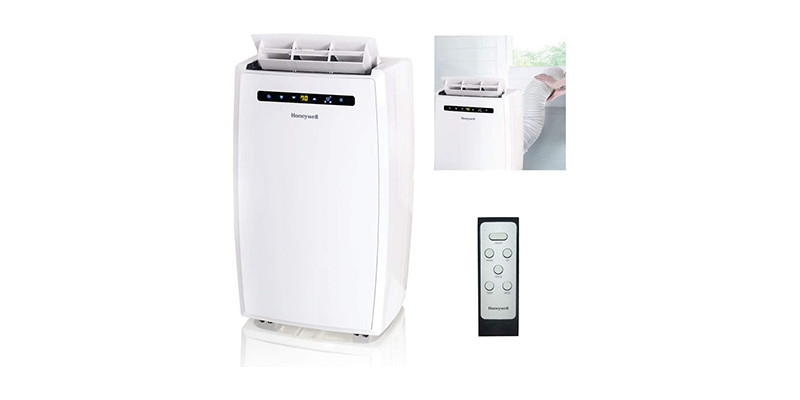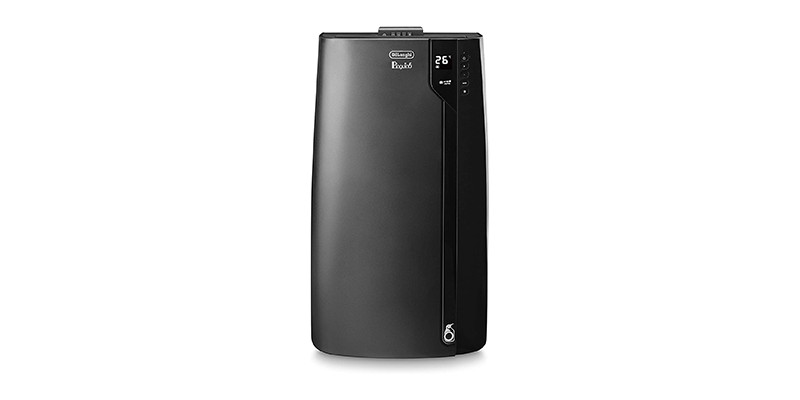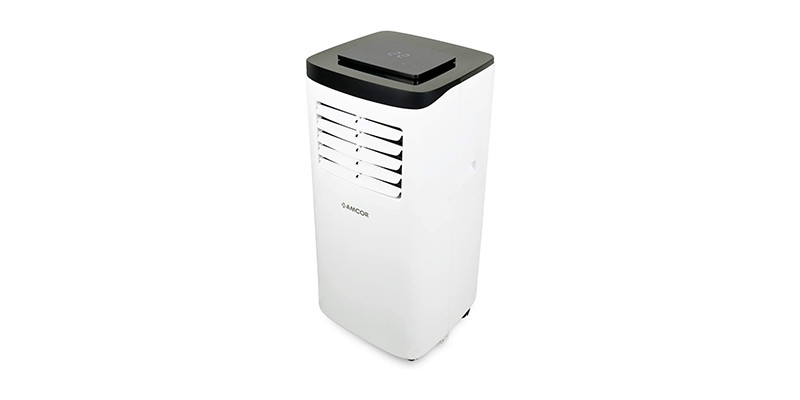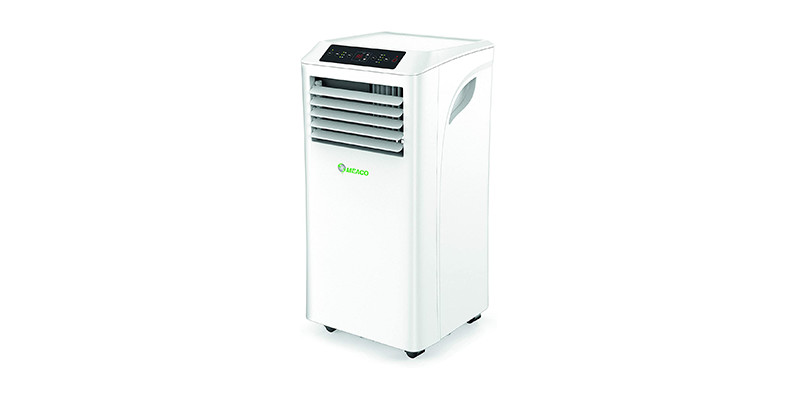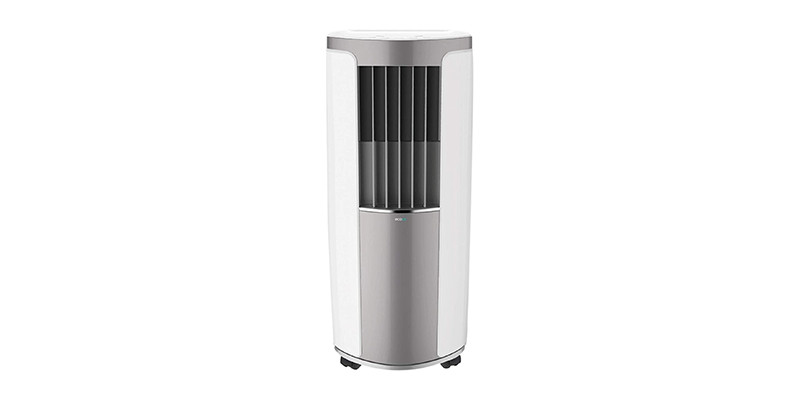With the weather getting hotter than ever, searching for the best air conditioner unit becomes mandatory. As you are about to discover, this category’s popular products are never just the small, compact, and portable room air conditioner you thought you’d get.
Top-of-the-range units can both cool and heat the air. Most average products will come equipped with cooling, fan, and dehumidifying functions. Typically, they require a window kit as they rely on an exhaust hose. Yet there are also fancy units that will evaporate water.
How do you navigate between all these options?
With our portable air conditioner buying guide from below, of course! As always, we’ll deep-dive into the review of the best personal air conditioner models.
Best Air Conditioners
| # | PREVIEW | Product | |
|---|---|---|---|
| 1
Best For Low Budgets
1Honeywell MN12CESWW Portable Air Conditioner
|
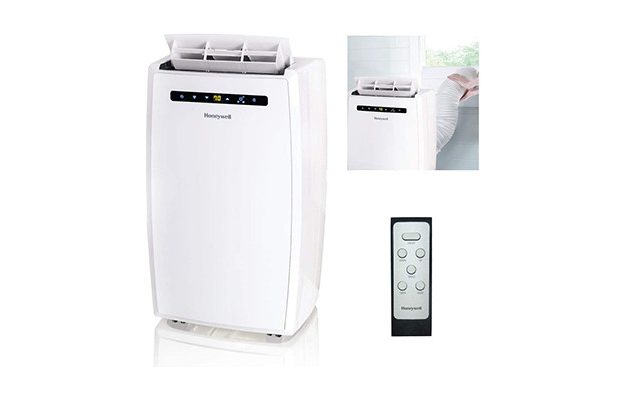
|
|
|
|
|
|||
| 2
Best Overall
2De'Longhi PACEX120 Air Conditioner
|

|
|
|
|
|
|||
| 3 |
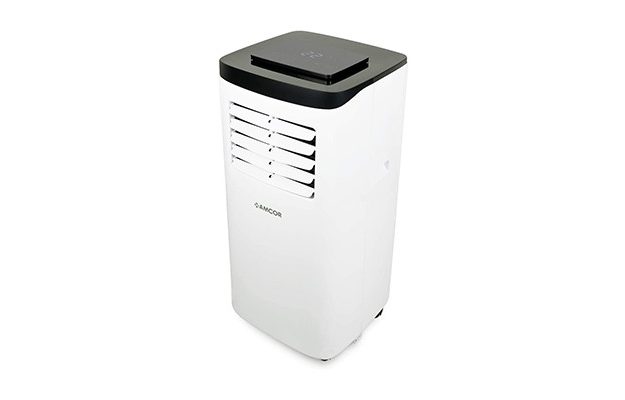
|
|
|
|
|
|||
| 4 |

|
|
|
|
|
|||
| 5
Best For Higher Budgets
5EcoAir APOLLO Air Conditioner
|
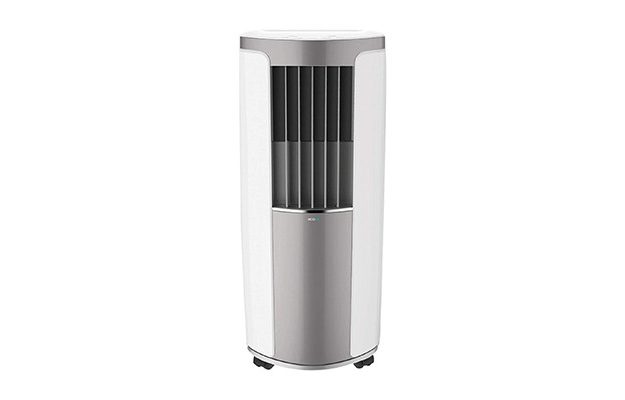
|
|
|
|
|
|||
1. Honeywell MN12CESWW Portable Air Conditioner
- Portable air conditioner with fan and dehumidifier functions.
- Cooling capacity of 12000 BTU.
- Covers rooms of up to 35 – 50 sq. m.
- Features 3 fan speeds and comes with remote control.
With the Honeywell MN12CESWW, you get a portable air conditioner, a fan, and a dehumidifier. From basic functionalities for everyday comfort to a welcomed help on rainy, humid days, it will serve you well on all weather.
It is powerful enough to make a difference in a room of up to 50 sq. m. Thanks to its thermal overload protection it is also safe to use. Not to mention that the 12- to 47-inch exhaust hose and the remote control give you more flexibility.
Wondering about the maintenance? You’ll be happy to see that the filters only require a regular cleaning under a faucet. All while ensuring effective dust & hair protection, for prolonged product life.
Specifications
Pros
- Powerful and effective.
- Facilitates quick installation.
- Takes little maintenance.
- Versatile 3-in-1 appliance.
Cons
- Exhaust hose forces placement next to a window.
- No sleep mode.
2. De'Longhi PACEX120 Air Conditioner
- Air conditioning unit that runs on propane R290.
- Maximum cooling capacity of 12,000 BTU for 110 m3 rooms.
- Silent technology with no sound interference.
- Innovative LED display and 12-hour digital timer.
Thanks to the De’Longhi PACEX120 Silent Pinguino, you’re getting a portable air conditioning unit with an impressive cooling capacity and a surprising energy efficiency rating.
The digital control with LED display is very intuitive and makes operation simple. Yet the cherry on top is the silent technology that scores as little as 53 dB when running at full capacity.
Elegant and compact, the unit has wheels and side-carry handles that make it easy to move around. It also comes with a remote control, which you can easily tuck inside the integrated remote-control holder.
All in all, it cools the room quickly and keeps the temperature to a comfortable level. The elegant design, the attention to detail, and all its extra functionalities make it well worth the investment.
Specifications
Pros
- Features De’Longhi’s greatest coverage area for a portable unit.
- Makes an eco-friendly choice, with no greenhouse emissions.
- Saves money on your electricity bill, with A energy efficiency.
- Facilitates comfortable operation with immediate comfort status feedback.
Cons
- Not the most budget-friendly option out there.
- Doesn’t include an auto shutoff function.
3. Amcor SF8000E-V3 Mobile Air Conditioner
- 7000 BTU air conditioner with cooling and dehumidifying function.
- Cools spaces of up to 18 sq. m. at an A energy efficiency rating.
- Built with a digital control panel and remote control.
- Features a compact case that sits on castor wheels.
Amcor’s All-In-One air conditioner comes in handy for those looking to cool a small to medium-sized room. Lightweight, with wheels and handle, it is portable and can sit anywhere near a sliding window.
The package includes a 1.5m hose and the required window kit to set it up without hassle. Speaking of which, once you get it up and running, going through its settings is a walk in the park.
Count on its timer, Up and Down controls, fan speed and mode buttons to make it accommodate your cooling preferences. With everything you need to know being displayed on the digital control panel.
If you have a small room and are looking for a simple, no-fuss portable unit that also dehumidifies the air, you’ll want to give this model a chance!
Specifications
Pros
- Versatile unit with 3 different functions.
- Compact, lightweight, and portable.
- Low power consumption.
- Features washable filter.
Cons
- Requires an exhaust hose.
- Only suitable to use with sliding windows.
4. MeacoCool MC Portable Air Conditioner
- 7000 BTU portable air conditioner for 12 – 22 sq. m. rooms.
- Designed with digital display and remote control.
- Works with R290 refrigerant gas, at around 53 dB noise level.
- Class A energy-efficiency rating.
With a 7000 BTU cooling capacity, Meaco’s portable air conditioner promises to handle anything from 12 to 22 sq. m. bedrooms, living rooms, or offices.
For the eco-conscious buyers, it matters that it uses R290 refrigerant. Or that it falls within the A energy efficiency class. After all, it’s nice to have an eco-friendly air conditioner unit without a whopping electricity bill.
A remote control backs up the built-in digital display, so you can switch between its modes from a distance, comfortably. Which means that adjusting its temperature for day or night time can’t get any easier.
Should you have to move it, rest assured that this compact unit with castors won’t break your back. Though chances are you’ll set it up next to a window with the built-in window kit, leave it there, and just enjoy it.
Specifications
Pros
- Facilitates effective cooling.
- Easy to control, includes even a sleep mode.
- Operates quietly, with low-energy consumption.
- Backed by a 2-year warranty.
Cons
- Hose not compatible with all window types.
- Water drainage hose must be bought separately.
5. EcoAir APOLLO Air Conditioner
- 12000 BTU portable air conditioning unit with both cooling and heating functions.
- Package includes 1.5 m vent hose and washable mesh filter.
- Features a self-evaporating system and A+ energy efficiency.
- Built with wireless remote control and memory function.
This mobile air conditioning unit from EcoAir looks outstanding and packs in some appealing features. Relying on a 12000 BTU pump, it can set up whatever temperature you need – low or high – in no time.
To top off the cooling and heating, it also works as a dehumidifier. But perhaps the feature that will catch your eye the most is the special self-evaporating system that spares you from dealing with water evacuation.
With wireless remote control, LED display, memory function, built-in timer, sleep function, and auto restart, it really looks as if no function is overlooked.
Designed for a space of up to 22 sq m, it’s a portable, energy-efficient, all-year-round air conditioner. And did we mention its anti-mildew X-fan that dries the interior of the unit, preventing the nasty unwanted mould?
Specifications
Pros
- Can either cool or heat the room.
- Convenient bucket-less design.
- LED display with memory function.
- Portable unit with castor wheels.
Cons
- Louvre fans require manual adjustment.
- Slightly louder compared to other models.
Air Conditioner Buying Guide
Type
The main types of air conditioners are mono-block, split-systems, and multi-split-systems.
The mono-block models consist of only one block (see the portable, window, or wall-mounted models from below).
The split-systems have two separate elements linked together, one for the inside, and one for the outside of the building.
The multi-split-systems have multiple blocks, but only one element for the outside of the building. All the elements from the inside of the building rely on the one from the outside.
Portable Air Conditioner
A portable air conditioner, also known as mobile air conditioner, typically consists of a cooling unit with a flexible air pipe.
The pipe is routed through a hole in a wall or straight through the window. Its main purpose is to evacuate the hot air extracted from the room.
Because it is quite affordable and doesn’t require installation, it is highly popular. Its main drawbacks are the somewhat limited capacity and the noise level.
Window Air Conditioner
A window air conditioner, also known as window rattler, consists of a cooling unit that sits into the opening of a window or through a narrow wall.
Basic models have the limited capacity of chilling the air. Whereas the more advanced ones come with remote control and even double the cooling option with a heating mode.
Easy to fit and with a decent price, a window air conditioner is still quite noisy. Moreover, it cannot be mounted in walls thicker than 9 inches, as it wouldn’t be able to function in such a setting.
Wall Mounted Air Conditioner
A wall mounted air conditioner, also known as high-wall air conditioner, is specifically designed for installation up on the wall.
It comes with a built-in condenser and two air pipes that must be routed outside, straight through the wall. Therefore, it makes a great choice for older buildings where having an external condenser unit is not an option.
Such units can also reverse their cooling function, to heat the air in winter. But they really are bulkier, and their installation involves drilling through the wall.
Split Air Conditioner
A split air conditioner is easy to recognize by its two-piece design, with an outer and an inner component. Linked through an electric cable, the two components also share two copper pipes that serve as a transport mean for the refrigerant.
The part that hosts the compressor is, as you can imagine, the noisiest and also the bulkiest, representing the outer component. Whereas the inner component is the smaller, lighter, and quieter part.
Depending on the model – because there are several different types of split air conditioners – the internal component can sit pretty much anywhere in the inside air space.
Apart from the unique design, a split air conditioner usually features sophisticated controls. In most cases, it also has a built-in heat pump, which allows it to heat the air in winter.
Size
Cooling units come in many different sizes. If you want a small air conditioner, perhaps even a mini air conditioner, you’ll most likely have to look into the portable options from the market or buy a cooling fan.
With certain variations, a portable unit will be sized around 40 x 40 x 80 cm, weighing between 20 and 30 kg. Portability-wise, such a model would most likely be designed with castor wheels and handle.
Clearly, you can find units way smaller than that. But know that a small/mini size would typically force you to make compromises in terms of functionality.
More exactly, for a mini air conditioner of 16 x 15 x 16 cm, you might actually be getting an air cooler rather than a typical air conditioning unit.
Power
The power of an air conditioner unit is expressed in watts. It defines the electrical energy that the unit requires to make its mechanisms run. Depending on how much you’ve used it, you’re going to see those watts displayed on your electricity bill.
A rough estimation indicates that a medium-sized window unit would use around 900 W. A central A/C unit with fan only would use around 750 W with the compressor turned off. Whereas a central air conditioner unit would use 3500 W.
12v Air Conditioner
A 12V air conditioner unit is designed to work with a 12-volt outlet. Such a unit will most likely not have a built-in condenser. The way it works is by relying on ice, which means you’ll have to pack it with ice, first, so it can blow cold air while powered at only 12 volts. The alternatives without ice are actually more like 12V fans.
Placement & Room Size
The type of personal air conditioner you choose will directly impact your comfort. Some designs come with placement limits, not to mention that their BTU will determine what room size they can cool.
Placement-wise, portable units can sit anywhere, as long as you make it possible for their flexible air hose to reach a window. If it’s a wall air conditioner, it can only be mounted on an exterior wall. If it’s a window air conditioner, it will typically sit lower than a room model.
Size-wise, for a small room of approximately 18 sq m, you will need an air conditioner with a BTU of at least 7000. Go higher, to 10,000 BTUs if your room is midsized, meaning around 24 sq m. But also take into account the heat sources from that room!
For instance, a 7000 BTU room air conditioner may be great for a single-person bedroom. In there, you’d typically expect to have just one person and no heat source or a TV at most.
But if you’re planning on using the same model in an office, where there will be several persons and some devices – like PCs and monitors, printers, whatever – it will clearly be inefficient.
Bedroom Air Conditioner
There are no air conditioners specifically labelled for bedroom use. Yet there are certain features you might notice in a model that would make it an ideal bedroom air conditioner.
Apart from making sure that the BTU is more than enough for the size of the bedroom, you must also want your air conditioner unit to have a remote control.
It should be as quiet as possible – know that 52 dB is the hair dryer’s noise level. This means that you’ll want to aim for something around 25 dB for a bedroom air conditioner.
Last but not least, you want your bedroom air conditioner to feature a sleep mode.
Features
A remote control is a basic feature, but if it has night light function, it is certainly an upgrade. The adjustable fan speeds, cool AND heat functions, dehumidifying function, or air improvement are other features you’d want from your air conditioner.
If we are to look into some less common, superior air conditioner features, we’d have to mention the following two:
Dual Hose
A dual-hose unit has two hoses instead of one. Each hose has its specific functionality, together making the air conditioner more efficient. Specifically, one hose serves as an air exhaust hose; the other draws in the air from outside.
The unit uses the air from the room to cool it down and recirculate it. But its internal components are getting hot in the process. That’s where the second hose comes in – it draws in air from the outside, which is cooler than the heated one from inside the unit, and helps cool the parts.
A dual hose portable air conditioner typically has a greater cooling capacity – matched against a single-hose model at the same size. Not to mention that it is more efficient, too.
Evaporation
An air conditioner that relies on evaporation has a thick pad that gradually absorbs water from a small reservoir.
It passes the warm air through the wet pad, facilitating the evaporation of the water and dropping the temperature inside the cooler with up to 20 degrees! A fan will then blow out the air that was so efficiently cooled.
With an evaporative air conditioner, buyers can get even more fancy features. Top-of-the-range models may include filters that will improve air quality. People with allergies or those living in homes prone to mildew will take the most advantage from such a unit.
Noise Level
The noise level is quite a controversial issue when it comes to air conditioners. That’s because most people are prone to pick a portable air conditioner, which doesn’t score the lowest noise levels.
For your information, the quietest portable air conditioner could be around 53 dB. As mentioned above, this is comparable to the sound of a hair dryer. If you’re willing to give up on the flexibility provided by a portable unit, there are other options as quiet as 25 dB.
Cleaning Air Conditioner
Given its functioning principle, an air conditioner requires regular maintenance. Cleaning it is part of that maintenance, and it mostly involves the filters, the coils, and the fins.
When these parts are clean, the unit works more efficiently. While you could do it yourself, for the most part, it is advisable that you bring in a professional once a year.
An air conditioner technician will run maintenance with professional cleaning products, specifically designed for these parts, to which you probably don’t have access.
How Much is an Air Conditioner?
Prices vary depending on the model you choose. The complexity of the installation and the company you choose for the job will also add up to the bill.
Yet strictly speaking about how much is an air conditioner unit, you can expect to pay between £300 and £600 for a portable model.
A cheap air conditioner can be even slightly lower than £300, though you’ll have to ask yourself if it really is the best investment for your money.
Frequently Asked Questions

At its core, an air conditioner is a unit that draws in the warm air from your home, cools it down, and blows it out. It does so in a continuous cycle meant to maintain your desired temperature.
The cooling mechanisms can vary from one model to another. Some units will cool the air and recirculate it through the same chamber. Others work with two interconnected components.
In a nutshell, the working principle behind an air conditioner is the same as the one from a refrigerator. Your room’s walls act for the air conditioning unit like the exterior housing of the fridge works for its cold box.

Regular service for the car air conditioning system should be performed every 2 years. That’s because mechanics confirm that the air-con typically leaks around 10% of its gases within one year.
The system cannot properly work with only 80% gas in the installation, hence the need to check the installation and replenish liquids every two years.
Our Verdict
Choosing the best personal air conditioner will give you an unrivalled level of comfort. Especially if it’s a unit that can both cool and heat the air (bonus point if it acts as a dehumidifier, too), a home air conditioner can prove one of the smartest investments.
From De’Longhi and Honeywell, to Meaco, EcoAir, or Amcor, there’s no shortage of options. These are some of the most popular air conditioner brands in the UK. And we’ve reviewed their top-rated products already.
Consider the information provided in this guide to pick a model that is user-friendly, effective, and that won’t make your energy bill go up while you’re cooling down!

